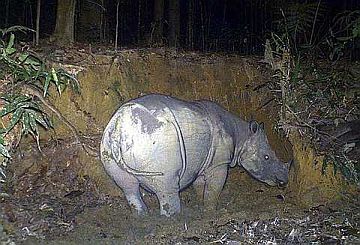By RUBEN SARIO, The Star, 19 April 2010
KOTA KINABALU: Wildlife experts here remain hopeful about the future of the highly endangered Sumatran rhino following a rare picture of a 20-year-old female that is believed to be pregnant. The picture of the female rhino was captured by remote camera trap devices set up jointly by the Sabah Wildlife Department and WWF-Malaysia. The picture was considered rare as there were estimated to be less than 30 rhinos left on the entire island of Borneo.

International Rhino expert Dr. Terri Roth said she was hoping that the female rhino was indeed pregnant.
“There are so few Sumatran rhinos left in the world that each calf represents a lifeline for the species, she said here Tuesday.
Sabah Wildlife Department director Dr Laurentius Ambu said the department was working with WWF-Malaysia and the Borneo Rhino Alliance (BORA) to finalise the Rhino Action Plan that which would be expected to be ready for full implementation by August this year. The plan would address the conservation plans of the viable population including isolated rhinos, Dr Laurentius added. He said his department intended to take a “different” approach in managing the viable but isolated rhino population in Sabah.
Habitat protection and enforcement have been recognised as the main strategy in order to ensure the survival of the viable rhino population in forest reserves, while a breeding programme has been identified as the key strategy in order to address the conservation plan for the isolated rhinos, Dr Laurentius added.
The rhino breeding programme is currently supported by Sime Darby, the Malaysian federal government and WWF-Malaysia. The future of rhinos in Borneo now depends on how seriously the enforcement and security work in the forest reserves can be implemented and coordinated, said Raymond Alfred, Head of the Borneo Species Programme, WWF-Malaysia. The monitoring and survey work in the central forest of Sabah is currently supported by HONDA Malaysia, WWF-Netherlands, WWF-Germany and USFWS since 2005.
WWF-Malaysia is working with the department and the Sabah Forestry Department to look into reinforcing the security of the forest reserves that are the key habitats for the animals. Alfred noted that that data from an ongoing rhino monitoring and survey programme showed that the animals’ home range was affected by oil palm plantation expansion near the state’s coastal areas. The research also indicated that sustainable logging activities had minimal impact on the rhino population while conversion of forests especially those located adjacent to key rhino habitat into other mono-crop plantations such as oil palm would further worsen the fragmentation of the rhino population.